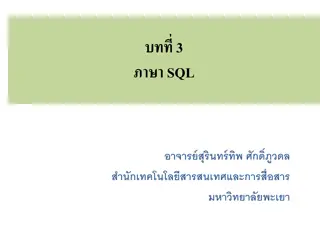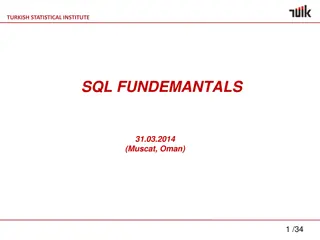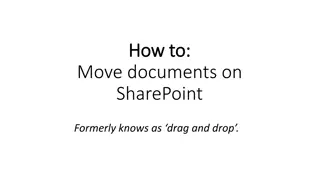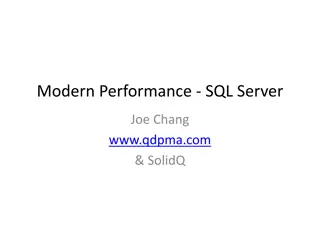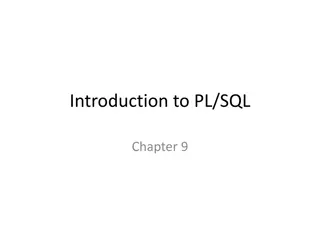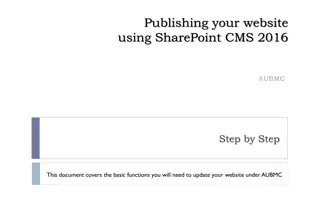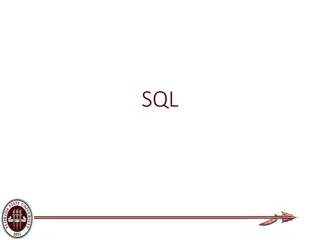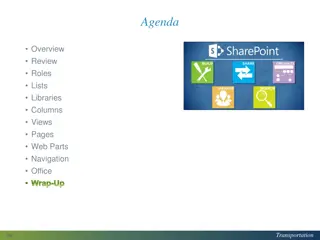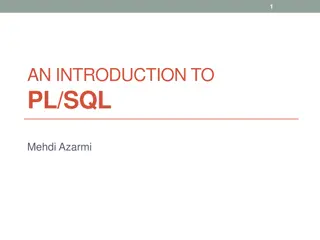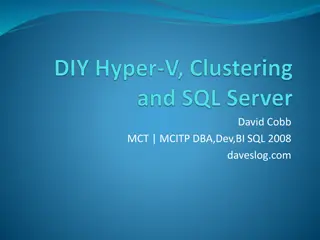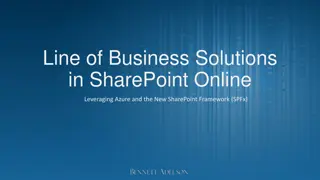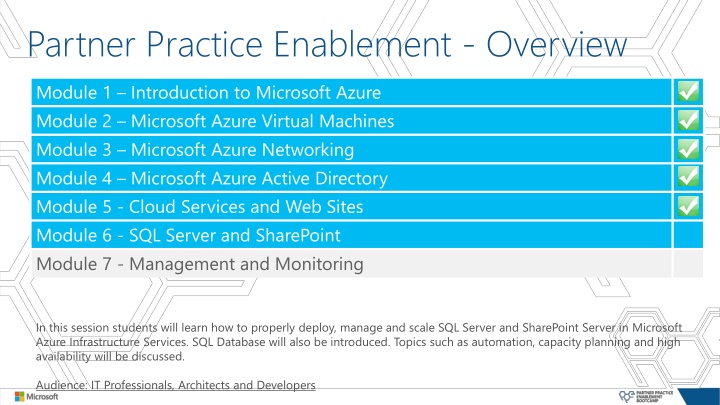
Deploying SQL Server and SharePoint on Microsoft Azure Infrastructure Services
Learn how to deploy, manage, and scale SQL Server and SharePoint Server in Microsoft Azure Infrastructure Services. Topics include automation, capacity planning, high availability, and introducing Azure SQL Database. Suitable for IT professionals, architects, and developers.
Download Presentation

Please find below an Image/Link to download the presentation.
The content on the website is provided AS IS for your information and personal use only. It may not be sold, licensed, or shared on other websites without obtaining consent from the author. If you encounter any issues during the download, it is possible that the publisher has removed the file from their server.
You are allowed to download the files provided on this website for personal or commercial use, subject to the condition that they are used lawfully. All files are the property of their respective owners.
The content on the website is provided AS IS for your information and personal use only. It may not be sold, licensed, or shared on other websites without obtaining consent from the author.
E N D
Presentation Transcript
Partner Practice Enablement - Overview Module 1 Introduction to Microsoft Azure Module 2 Microsoft Azure Virtual Machines Module 3 Microsoft Azure Networking Module 4 Microsoft Azure Active Directory Module 5 - Cloud Services and Web Sites Module 6 - SQL Server and SharePoint Module 7 - Management and Monitoring In this session students will learn how to properly deploy, manage and scale SQL Server and SharePoint Server in Microsoft Azure Infrastructure Services. SQL Database will also be introduced. Topics such as automation, capacity planning and high availability will be discussed. Audience: IT Professionals, Architects and Developers
About the Instructor CEO & Co-Founder of Opsgility, Experts in Instructor-Led Microsoft Azure Training. Prior to starting Opsgility Michael was a Principal Cloud Architect with a leading Solution Integrator and a fifteen year Microsoft veteran. While at Microsoft Michael's roles included being a Senior Program Manager on the Microsoft Azure Runtime team and a Senior Technical Evangelist for Microsoft Azure Infrastructure Services. Michael was the original developer of the Microsoft Azure PowerShell Cmdlets and is a globally recognized speaker for conferences such as TechEd and BUILD. Michael Washam Microsoft Azure Trainer http://www.opsgility.com Twitter: @MWashamTX michael@Opsgility.com
SQL Server and SharePoint on Microsoft Azure
Agenda SQL Server in Microsoft Azure Introducing Azure SQL Database SharePoint Server in Microsoft Azure
SQL Server and Microsoft Azure
SQL Server and Microsoft Azure Virtual Machines Supported Versions SQL Server 2014, 2012, 2008 R2 Supported Features All SQL Server features supported SQL Server Provisioning Cloud-first using stock images, bring your own server / VHD, capture cloud images SQL Server Licensing Pay by the hour or migrate your own license via Software Assurance ** ** Microsoft Azure Compute, Bandwidth and Storage charges also apply
Bring your own License Create your own Image 1. Create a VM based on base Windows Server image 2. RDP into server 3. Follow instructions for creating a sysprepped image of SQL Server: http://technet.microsoft.com/en- us/library/ee210664.aspx 4. Run SysPrep and Shutdown the Virtual Machine 5. Capture the VM
Full Production Environment Development and Test Environments Common Scenarios Cloud-based backup of on-premises data SQL Server Always On w/ cloud- based secondary's
Running SQL Server in a Microsoft Azure VM Storage Recommendations Verify Disk Cache Settings on Data Disks (See whitepaper link below) Avoid using OS drive for databases Put database and transaction log files on separate drives Use SQL Server File Groups instead of Disk Striping Database Recommendations Consider using database page compression to reduce I/O High Availability Recommendations Consider latency between primary and replica when choosing sync mode Use Availability Sets More at http://go.microsoft.com/fwlink/?LinkId=306266
More on Storage Performance Considerations Do not use the temporary disk (D:\) (including for TempDB) Use SQL file groups across multiple disks instead of disk striping Put logs, data and backup on separate disks Disable geo-replication on storage account for consistency Remember storage account capacity planning. 20,000 IOPS per Storage Account 500 IOPS per disk Consider compressing any data files when transferring in/out of Microsoft Azure. More at http://go.microsoft.com/fwlink/?LinkId=306266
Migrating to Microsoft Azure Right-size the VMs Cost impact will pay compute, storage and bandwidth charges Data Import and Export service for large data sets: http://www.windowsazure.com/en-us/documentation/articles/storage-import-export-service Supported Versions Bring your own 2008, 2008 R2, 2012, 2014 Platform 2008 R2, 2012, 2014 Licensing Considerations BYO License Mobility via Software Assurance Platform Included in the per hour rate Understand platform image configuration differences More at http://msdn.microsoft.com/library/windowsazure/dn133142.aspx
Security Security Considerations Similar practices as on-premises Regulatory Compliance - Microsoft Azure Trust Center http://www.windowsazure.com/en-us/support/trust-center/ Remove unused public endpoints Consider a Point to Site or Site to Site VNET for administration Set ACL to limit IPs and/or subnets More at http://msdn.microsoft.com/library/windowsazure/dn133147.aspx
SQL Server Microsoft Azure Integration SQL Server 2012 Backup to Microsoft Azure blob storage (PowerShell or T-SQL), On-premises and Microsoft Azure SQL Server 2014 Database Migration to Microsoft Azure SQL Server Always On Hybrid (On-Premises and Replica in Microsoft Azure) SQL Database files can be created directly in Microsoft Azure Storage SQL Server Backup to Microsoft Azure Storage URL or fully Managed with UI Integration
High Availability and Disaster Recovery Key Scenarios High Availability within Microsoft Azure Disaster Recovery between on-premises and Microsoft Azure Disaster Recovery across Microsoft Azure Data Regions More at http://msdn.microsoft.com/en-us/library/windowsazure/jj870962
HA - SQL Always On Availability Groups Up to 4 Replicas Can be read only Microsoft Azure Virtual Network Replica Authentication Active Directory Active Directory SQL Availability Group Availability Set: SQLAVSET Dependencies Active Directory Virtual Network Availability Set Automatic failover with listener (secure with ACL) SYNCHRONOUS COMMIT Listener (1433) SECONDARY WITNESS PRIMARY
HA - SQL Always On Availability Groups Hybrid Microsoft Azure Virtual Network Up to 4 Replicas Can be read only SECONDARY Replica Authentication Active Directory ASYNCHRONOUS IP SEC Dependencies Create Availability Group on- premises Establish VPN Add Secondary Replica in Microsoft Azure COMMIT On-Premises SQL Server Availability Group SYNCHRONOUS COMMIT WITNESS PRIMARY SECONDARY
HA - SQL Server Mirroring Replica Authentication Active Directory Certificates Microsoft Azure Virtual Network Active Directory SQL Mirror Setup Virtual Network Availability Set Establish mirror with witness (Witness for automatic failover) Availability Set: SQLAVSET SYNCHRONOUS COMMIT SECONDARY WITNESS PRIMARY
DR - Spanning Cloud Azure Regions SQL Mirroring or Always On with a Regional Virtual Network or ExpressRoute ASYNCHRONOUS COMMIT West US East US IPSEC/VPN ExpressRoute Circuit PRIMARY SECONDARY
DR SQL Backup/Restore Using Blob Storage Backup or Restore using Microsoft Azure Storage Highly Available and Durable with 3 Local Copies of all Blobs Enable Geo-Replication for 3 additional copies in a remote region SQL can be on-premises or cloud based Microsoft Azure Storage West US Backup DB Restore DB SQLVM
DR: SQL Log Shipping Microsoft Azure Virtual Network SQL Shipping Uses File Share (SMB) Requires Active Directory and VPN for offsite disaster recovery. SECONDARY ACTIVE DIRECTORY LOG SHIPPING / SMB IP SEC On-Premises PRIMARY ACTIVE DIRECTORY
Introducing SQL Database Delivers Database-as-a-Service functionality, based on SQL Server and hosted in Microsoft Azure Focuses on predictable performance, scalability, business continuity, data protection, zero administration, and familiar tools
Service Tiers Predictable performance and business continuity Standard Typical workgroup or web application Multiple concurrent transactions Basic Small database Single operation at one point in time Premium Mission-critical applications High volume of concurrent transactions Up to 250 GB DB Size Up to 500 GB DB Size Up to 2GB DB Size Web and Business tiers are being retired
Predictable Performance Performance Level Measured in Database Throughput Units (DTUs) DTU = unit of measurement for power of combined CPU, memory, physical reads, and transaction log writes DTUs allow comparison of resources that power different performance levels Transaction Rate Transactions per units of time (in benchmark testing) Predictability Consistency of response time
Predictable Performance Service Tier Performance Level Maximum Sessions Transaction Rate DTUs Predictability Basic Basic 5 100 3,467/hour Good Standard S1 15 200 283/minute Better S2 50 500 1,470/minute Better Premium P1 100 2,000 98/second Best P2 200 4,000 192/second Best P3 800 16,000 730/second Best
Predictable Business Continuity Service Tier Performance Level Point in Time Restore Disaster Recovery Database copy and Manual export Basic Basic From the past 7 days Standard S1 Database copy and Manual export From the past 14 days S2 Premium P1 P2 From the past 35 days Active geo-replication P3
SQL Server vs. Microsoft Azure SQL Database SQL Server (IaaS) Microsoft Azure SQL Database (PaaS) Development Migrate Existing or Build New Apps Develop New Apps Management Full Control Managed Service Compatibility Full SQL Server Capabilities Based on SQL Server Technology Shared Technology Network transport (Tabular Data Stream) SQL dialect (Transact-SQL) Data access APIs (ADO.NET, ODBC, JDBC) Development tools (SQL Server Data Tools) Management tools (SQL Server Management Studio) More Information: http://blogs.msdn.com/b/windowsazure/archive/2013/02/14/choosing-between-sql- server-in-windows-azure-vm-amp-windows-azure-sql-database.aspx
DEMO SQL Database
SharePoint Server and Microsoft Azure
SharePoint Cloud Continuum Value Prop Auto HA, Fault-Tolerance Friction-free scale Self-provisioning, mgmt. @ scale COST-EFFICIENCY Office 365 (SaaS) Value Prop 100% of API surface area Easy migration of existing apps Roll-your-own HA/DR/scale Value Prop Full h/w control size/scale Roll-your-own HA/DR/scale SharePoint Service SharePoint (IaaS) SharePoint (On-premises) Hosted SharePoint SharePoint CONTROL
Product Support SharePoint Server 2010 and 2013 supports the hosted virtualization solution of Microsoft, as well as required technologies, such as Microsoft SQL Server, when these products and technologies are deployed on the Microsoft Azure platform. SharePoint Support on Microsoft Azure FAST Support Do not support Microsoft FAST Search Server 2010 for SharePoint deployments on Microsoft Azure.
VM Gallery SharePoint 2013 Trial Farm install wizard not executed Not configured for single-server install (best for multiple servers AD server and SQL Server) Can be upgraded to fully licensed version
SharePoint Architecture Tips IOPS Most Important Factor Optimize SQL Server Storage Only SharePoint is on the C: drive Scale Out Not Up Move content databases to separate SQL Servers Move search databases to separate SQL Servers Add more WFE for scaling SharePoint services Add dedicated Search Servers and SQL Server
Microsoft Azure and SharePoint Tips Remember: Availability Sets give your VMs hardware level high availability Have the load balancer help determine when your web front ends are available for additional HA. Deploying and managing SharePoint in the cloud can be scripted. Remember a Stopped VM doesn t charge you!
SharePoint 2013 Deployment Option 1 PowerShell Automation Scripts PowerShell Scripts that use Remote PowerShell for automated deployment of Active Directory, SQL Server and SharePoint 2013. Two Sample Configurations Available (uses Trial Image) HighlyAvailable and SingleVMs Download from GitHub https://github.com/windowsazure/azure-sdk-tools-samples Option 2 SharePoint Server Farm deployment in the Azure Preview Portal
Highly Available Template APP SQL WEB AD/DC/DNS LB Web Tier 2 x Large (4 Cores & 7 GB) AVSET SPWEB AVSET SQLHA AVSET DCSET AVSET SPAPP App Tier 2 x Large (4 Cores & 7 GB) 80 Data Tier 2 x A6 20000 Admin (4 Cores & 28 GB) 1 x Small (Quorum) (1 Core & 1.75 GB) Identity Tier Cloud Service 2 Small (1 Core & 1.75 GB) Virtual Network Microsoft Azure
Single Virtual Machines Template WEB/APP SQL AD/DC/DNS Web/App Tier 1 x Large (4 Cores & 7 GB) LB Data Tier 1 x A6 (4 Cores & 28 GB) AVET SPWEB AVSET SQL AVSET DCSET 80 Identity Tier 1 Small (1 Core & 1.75 GB) 20000 Admin Cloud Service Virtual Network Microsoft Azure
DEMO Deploying SharePoint 2013
Summary SQL Server in Microsoft Azure Introducing Azure SQL Database SharePoint Server in Microsoft Azure
Coming Up Next . . . Management and Monitoring Microsoft Azure Virtual Machines







